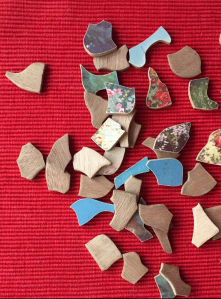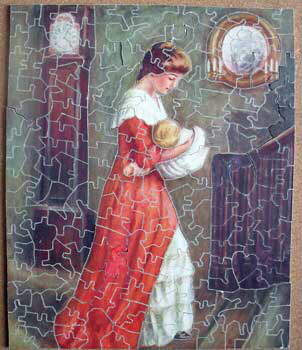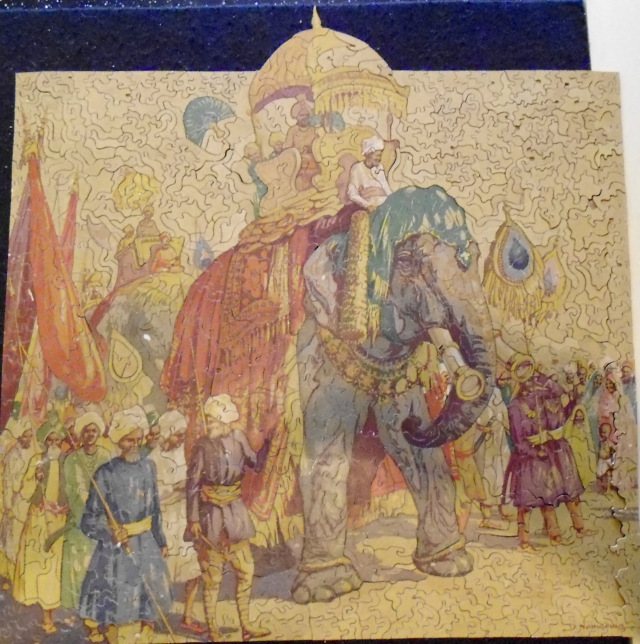What a thing to confess! I don’t remember my first time. It would have been after 2004, I imagine, so I would have been about 61 or thereabouts. I had been an antiques and collectables dealer for some years and had been to an auction somewhere in the south-east of England to see what I thought might amuse my customers – something they would buy at a slight profit to me, so that we could eat occasionally!
Whether it was Lewes or Ardingly, Maidstone or Rochester completely escapes me now but I spotted one or more large jigsaw puzzles already made up, backed by a piece of card and covered in cellophane. I thought that maybe someone might want to buy one or two and that they would look good in the shop. I spotted some more, still in their boxes and bought those as well.
The already made-up ones stayed in a pile in the store room but I took the boxed ones up to our flat, opened one and poured the pieces on to a large piece of green felt which was left over from one of my husband’s upholstery sessions. I thought, “There aren’t many pieces, this should be fun and easy!” then I looked at the pieces more carefully. There were no tabs and holes as there had been in all the jigsaws I had ever done before (not all that many and always cardboard). How in the world do I start? (Below are a few pieces from a non-interlocking jigsaw which I haven’t done yet.)

Well, I thought, do the edges first – except there were a lot more pieces with straight edges than would be necessary for the ‘frame’! What to do? Of course! Because the pieces are wooden, there is a grain which can (usually) be seen – if the grain isn’t straight, it’s not likely to be an edge piece. And so, I started. That first one wasn’t too bad, in fact. I used colour as a guide – blue sky next to blue sky, the sleeve of a black jacket next to the body of the same black jacket – and that worked well.
The next one wasn’t quite so easy, though. It was what I later learned was called ‘colour-cut‘ as well as ‘non-interlocking‘ (the official word for a jigsaw whose pieces don’t physically join up with tabs and holes). Colour-cut jigsaws eventually became my favourites but I really had to learn how to do them before I could love them! (In the picture below you can see that the right hand side of the grand-father clock has been colour-cut as have the woman’s dress, the mirror, the bannister etc.)

Possibly because of my aphantasia (see earlier blog), I can’t retain a picture in my head of the shape I just looked at in order to find the shape that will fit up against it. If a jigsaw is colour-cut, I can’t use colour as a clue. And, what I forgot to say, all the jigsaws I will mention came in boxes with no guide picture (and, unbelievably, often no maker’s name. The history of late nineteenth/early twentieth jigsaw puzzles is surprisingly interesting! If you want to know more, I could write a blog about it.)
Some years passed. We sold the shop, flat and workshop and retired to the seaside but took most of our left-over stock with us (and still have a cellar full of french polish, tack removers and mallets, and even a box of veneers, from when Julian also did furniture restoration). No one coming into our shop had bought the one made-up jigsaw I had displayed so it, and all the others, became my next project.
I started a web-shop called nostalgia games.net from which I sold vintage and antique games, quite successfully and, even more successfully, the jigsaws. In fact I gave up the games, eventually, and only bought and sold the wonderful old jigsaws. I bought many, many jigsaws from all over the country, lots from auctions and quite a few from private individuals via Ebay or people who saw my advert and rang me. Each and every one had to be laid out, made-up and photographed before it could be offered for sale on my site so I had to find ways of managing to put the really difficult ones together (or leave them to Julian who is very good at the most difficult ones). But, Julian found several part-time jobs over the years and I needed to get the jigsaws done so, after lots of effort, I became quite good at it. Many an evening I was to be found poring over pieces of wood with little bits of paper stuck to them.
Looking back, my favourites could be divided into two groups – the ones which used old Pear’s Soap adverts and the ones which had been travel posters or showed wonderful things happening in foreign parts. I will add one or two of the photos, as and when I find them on the memory stick over the coming months but here is one:

This jigsaw (which I sold a few years ago, now) has elements of interlocking, non-interlocking and colour cutting. It is from a painting of a gathering of many of the rulers of India in what was called a Durbar. (You can find out about Durbars on Google). I loved doing this jigsaw! It took a fair amount of time and has that bit at the top that sticks right above the rest of the edge to add to the difficulty. There are other jigsaws with no straight edges and some with only one or two. Even interlocking jigsaws sometimes are cut with few or no edges – several of the GWR train and ship jigsaws are like that.
I gave up buying and selling old wooden jigsaws about two years ago when they had become far more expensive than I could afford. Remember, when you buy a vintage jigsaw in a box you can’t stop to put it together before you pay and take it home. Many of the puzzles I bought were missing one, two or up to thirty pieces. I don’t mind if there are a couple missing; for me it doesn’t spoil a puzzle and my enjoyment of putting it together if it’s not all there but there are people who wouldn’t take on a puzzle they know isn’t complete. If you are one of those people, never buy one where the seller says it has the right number of pieces but they haven’t put it together. I bought one once on Ebay which was supposed, according to the box, to have 180 pieces and it had 180 pieces but they didn’t all come from the same jigsaw! In fact, thinking back, I think there were bits from about three or four.
Though I spent ten or more years studying jigsaws, finding out about the different types etc, there is still loads more to learn. If you are interested in finding out more, there is a good book called British Jigsaw Puzzles of the 20th Century by Tom Tyler and published by Richard Dennis. It is full of illustrations with quite a lot of interesting info about GWR puzzles as Tom worked for the makers, Chad Valley, at one time. There is also a very interesting book on early wooden jigsaws (from 1760 to 1890) called The English Jigsaw Puzzle by Linda Hannas and published by Wayland. Online there is a wonderful site called The Jigasaurus set up by David Shearer. It includes many makes of jigsaw and loads of info and illustrations plus how to join the Benevolent Confraternity of Disectologists (Dissectologists – it’s spelled both ways on Google.)
I’ve still got several jigsaws waiting for the winter when I won’t feel as though I’m wasting my time inside when I could be in the garden or at the beach. Having written about them today makes me want to start one now!
Share this:






